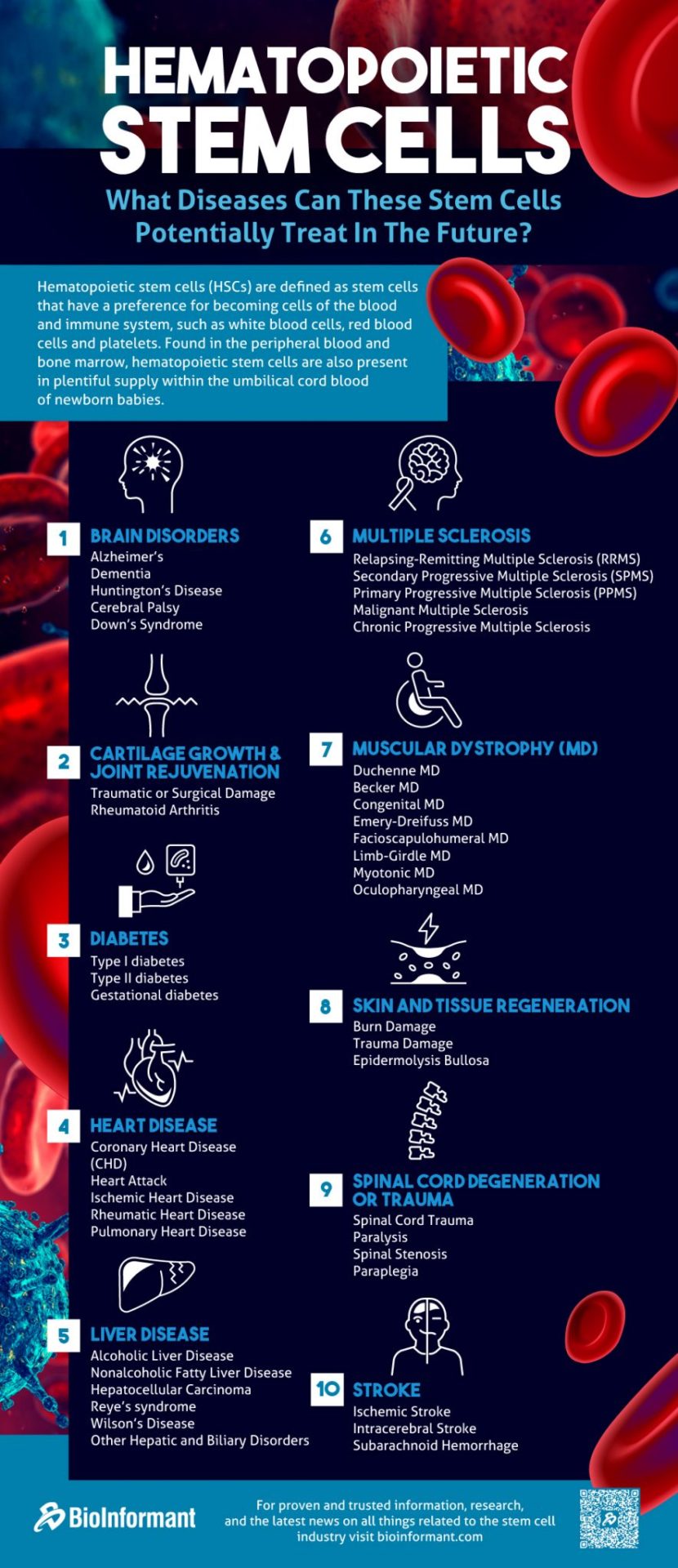|
|
Hematopoietic stem cells (HSCs) are defined as stem cells that have a preference for becoming cells of the blood and immune system, such as white blood cells, red blood cells, and platelets. Found in the peripheral blood and bone marrow, hematopoietic stem cells are also present in plentiful supply within the umbilical cord blood of newborn babies.
For the past thirty years, cord blood has been used within transplant medicine, including for the treatment of leukemia and other blood diseases. For most conditions in which a bone marrow or peripheral blood stem cell transplant is an option, a cord blood transplant is a potential alternative.
Hematopoietic Stem Cells
In this article:
- Human Cord Blood Cells
- Common Diseases Treatable with Cord Blood Transplant
- Allogeneic and Autologous Transplants
- Diseases Treatable with Hematopoietic Stem Cell Transplant in the Future
Hematopoietic Stem Cell Transplant as Treatment
Hematopoietic stem cells (HSCs) are the stem cells that repopulate the blood and immune system within humans, via a process known as haematopoiesis. For this reason, hematopoietic stem cell transplantation, better known as HSCT, can be a promising treatment approach for a wide range of conditions.
Human Cord Blood Cells
The use of human cord blood cells dates back as early as 1974, when it was first proposed that stem cell and progenitor cells were present in human cord blood. By 1983, the use of cord blood as an alternative to bone marrow had been proposed. Five years later in 1988, the first successful cord blood transplant to restore a patient’s blood and immune system cells took place in France.
In addition to a long history of use within transplant medicine, human cord blood cells are playing a growing role within regenerative medicine. Cord blood stem cells have been induced to develop into neural cells, suggesting that they may represent a potential treatment for neurological conditions, such as Alzheimer’s, Parkinson’s, spinal cord injury, dementia, and related conditions.
Human cord blood cells can also develop into blood vessels, making them promising for the repair of tissues following stroke, coronary heart disease, rheumatic heart disease, congestive heart failure, and congenital heart conditions.
Common Diseases Treatable with Cord Blood Transplant
It is also interesting to consider the common disease categories treatable with cord blood transplant, as shown in the table below.
| Common Disease Categories |
1. Cancers
|
2. Blood Disorders
|
3. Immune Disorders
|
4. Metabolic Diseases
|
Allogeneic and Autologous Transplants
There are more than 80 medical conditions for which transplantation of hematopoietic stem cells (including cord blood transplant) is a standard treatment option. Most of these therapies require allogeneic transplants, where the patient must use a genetically-matched cord blood donor. The only exceptions to this are patients who are transplanted for solid tumors or acquired anemias. In these situations, the patient may receive an autologous transplant.
Comprehensive lists of conditions treatable with hematopoietic stem cells are available here and here.
Diseases Treatable with Hematopoietic Stem Cells in the Future
In addition, there is a range of disease categories for which cord blood transplant could represent a viable treatment method in the future. For these conditions, there are still unknown criteria that need to be determined before the cord blood stem cell transplant can become commonplace, such as patient criteria for optimal treatment effectiveness, optimum stem cell quantity for use in transplant, and preferred method of stem cell delivery into the patient, as shown below.
1. Brain Disorders
|
2. Cartilage Growth & Joint Rejuvenation
|
3. Diabetes
|
4. Heart Disease
|
5. Liver Disease
|
6. Multiple Sclerosis
|
7. Muscular Dystrophy (MD)
|
8. Skin and Tissue Regeneration
|
9. Spinal Cord Degeneration or Trauma
|
10. Stroke
|
Download this infographic below to reference it later.

What do you think of the future of hematopoietic stem cell transplant? Share your thoughts in the comments below.




















Tell Us What You Think!